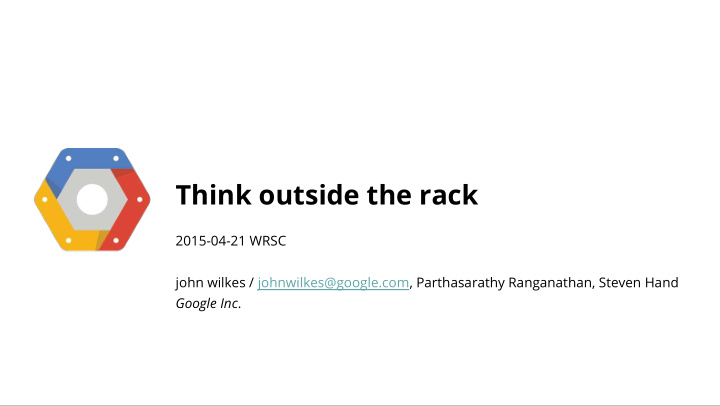



Think outside the rack 2015-04-21 WRSC john wilkes / johnwilkes@google.com, Parthasarathy Ranganathan, Steven Hand Google Inc .
Datacenter loads are not SPEC benchmarks Single query across multiple racks of multiple servers: graph of one query and associated RPCs for work distribution (only two levels shown); other queries going on, but not shown. Graphic from Dick Sites
Good news! lots of new technologies Silicon/hardware is getting ever more inventive forced to move to parallelism to track Moore's "law" Main memory: lots of volatile RAM, new non-volatile h/w Computation: oodles of cores, specialized accelerators Storage: flash/SSD, [magnetic disks still kicking] Networking: high bandwidth + low latency + lossless(?)
Good news! resource disaggregation Conceptually it's wonderful: Build a "rack computer" from a kit of parts (*) ○ a single big, disaggregated machine ○ all the benefits of a unified OS Build a "datacenter in a rack" (*) ○ a single, scaled-down distributed system, like the big guys use ○ all the benefits of shared-nothing distributed systems (*) OK - build at least two, for reliability
Good news! a RackScale foo is both of these Upsides: ○ meet all the needs of all but the largest organizations ○ buy just what you need (save money) ○ build just what you want (go fast) ○ tune for peak performance (go fast; save money) ○ conceptually similar to existing programming models What could possibly go wrong?
An RSfoo breaks everything An RSfoo is not the same as a computer ○ multiple internal failure domains ○ non-uniform resource access costs An RSfoo is not the same as a datacenter ○ shared nothing => disaggregated resources ○ existing programming models don't work
Datacenter experiences are relevant DRAM errors (1% AFR) A 2000-machine service will Disk failures (2-10% AFR) have >10 machine crashes per Machine crashes (~2/year) day OS upgrades (2-6/year) This is not a problem because of the shared-nothing model Images by Connie Zhou
RSfoo failures If disaggregation is used ○ each component failure ⇒ partial system failure ⇒ visible at the app level ○ fault propagation at the speed of light Apps aren't designed to handle this today
RSfoo provisioning How much of what to buy? ○ workload lifetime << hardware depreciation cycle ○ multiple esoteric resources ○ requires (dynamic) hardware evolution Apps + planning tools aren't designed to handle this today
RSfoo placement/scheduling Avoid resource stranding ○ disaggregation helps … ○ but RSfoo has more resource types Avoid bad placement ○ NUMA writ large ○ dynamic interference Existing placement / scheduling algorithms aren't good at this today
RSfoo inter-application interference RSfoos are small-scale datacenters, so will run multiple apps Disaggregated resources make ... ○ performance isolation much harder ○ security isolation much harder ○ failure isolation much harder Apps + systems aren't designed to handle this today
RSfoo groups You still need multiple RSfoos ... ○ control-plane failure ○ datacenter / network / environment failure ○ "big" workloads ○ end-user latency Existing inter-datacenter solutions (e.g., full replication) probably aren't ideal
Good news! We'll have job security ;-)
Good news! The solutions are in sight. The problems are just beginning. ○ Failures ○ Provisioning and configuration hassles ○ Interference ○ Multi-RSfoo support
One possible approach For each feature/property/behavior, start by asking: ○ "is this a big computer, or a small datacenter?" ○ (distributed systems techniques go a long way) Thinking about timescales may help: ○ seconds and up - datacenter control model ○ below that: application-level Introduce a feature after addressing issues identified here ○ don't forget the programming model!
Recommend
More recommend